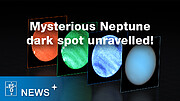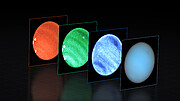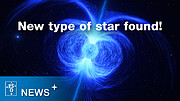Artist’s animation of the pulsar PSR J1023+0038
With a remarkable observational campaign
that involved 12 telescopes both on the ground and in space, including
three European Southern Observatory (ESO) facilities, astronomers have
uncovered the strange behaviour of a pulsar, a super-fast-spinning dead
star. This mysterious object is known to switch between two brightness
modes almost constantly, something that until now has been an enigma.
But astronomers have now found that sudden ejections of matter from the
pulsar over very short periods are responsible for the peculiar
switches.
“We have witnessed extraordinary cosmic events where
enormous amounts of matter, similar to cosmic cannonballs, are launched
into space within a very brief time span of tens of seconds from a
small, dense celestial object rotating at incredibly high speeds,”
says Maria Cristina Baglio, researcher at New York University Abu Dhabi,
affiliated with the Italian National Institute for Astrophysics (INAF),
and the lead author of the paper published today in
Astronomy & Astrophysics.
A pulsar is a fast-rotating, magnetic, dead star that emits
a beam of electromagnetic radiation into space. As it rotates, this
beam sweeps across the cosmos — much like a lighthouse beam scanning its
surroundings — and is detected by astronomers as it intersects the line
of sight to Earth. This makes the star appear to pulse in brightness as
seen from our planet.
PSR J1023+0038, or J1023 for short, is a special type of
pulsar with a bizarre behaviour. Located about 4500 light-years away in
the Sextans constellation, it closely orbits another star. Over the past
decade, the pulsar has been actively pulling matter off this companion,
which accumulates in a disc around the pulsar and slowly falls towards
it.
Since this process of accumulating matter began, the
sweeping beam virtually vanished and the pulsar started incessantly
switching between two modes. In the ‘high’ mode, the pulsar gives off
bright X-rays, ultraviolet and visible light, while in the ‘low’ mode
it’s dimmer at these frequencies and emits more radio waves. The pulsar
can stay in each mode for several seconds or minutes, and then switch to
the other mode in just a few seconds. This switching has thus far
puzzled astronomers.
"Our unprecedented observing campaign to understand
this pulsar’s behaviour involved a dozen cutting-edge ground-based and
space-borne telescopes," says Francesco Coti Zelati, a researcher
at the Institute of Space Sciences, Barcelona, Spain, and co-lead author
of the paper. The campaign included ESO’s Very Large Telescope (
VLT) and ESO’s New Technology Telescope (
NTT), which detected visible and near-infrared light, as well as the Atacama Large Millimeter/submillimeter Array (
ALMA),
in which ESO is a partner. Over two nights in June 2021, they observed
the system make over 280 switches between its high and low modes.
“We have discovered that the mode switching stems from
an intricate interplay between the pulsar wind, a flow of high-energy
particles blowing away from the pulsar, and matter flowing towards the
pulsar,” says Coti Zelati, who is also affiliated with INAF.
In the low mode, matter flowing towards the pulsar is expelled in a narrow jet perpendicular to the disc.
Gradually,
this matter accumulates closer and closer to the pulsar and, as this
happens, it is hit by the wind blowing from the pulsating star, causing
the matter to heat up. The system is now in a high mode, glowing
brightly in the X-ray, ultraviolet and visible light. Eventually, blobs
of this hot matter are removed by the pulsar via the jet. With less hot
matter in the disc, the system glows less brightly, switching back into
the low mode.
While this discovery has unlocked the mystery of J1023’s
strange behaviour, astronomers still have much to learn from studying
this unique system and ESO’s telescopes will continue to help
astronomers observe this peculiar pulsar. In particular, ESO’s Extremely
Large Telescope (
ELT), currently under construction in Chile, will offer an unprecedented view of J1023’s switching mechanisms.
“The
ELT will allow us to gain key insights into how the abundance,
distribution, dynamics, and energetics of the inflowing matter around
the pulsar are affected by the mode switching behavior,” concludes Sergio Campana, Research Director at the INAF Brera Observatory and coauthor of the study.
More Information
This research was presented in a paper to appear in Astronomy & Astrophysics (doi:10.1051/0004-6361/202346418)
The team is composed of M. C. Baglio (Center for Astro, Particle, and Planetary Physics, New York University Abu Dhabi, UAE [NYU Abu Dhabi]; INAF – Osservatorio Astronomico di Brera, Merate, Italy [INAF Brera]), F. Coti Zelati (Institute of Space Sciences, Campus UAB, Barcelona, Spain [ICE–CSIC]; Institut d’Estudis Espacials de Catalunya (IEEC), Barcelona, Spain [IEEC]; INAF Brera), S. Campana (INAF Brera), G. Busquet (Departament de Física Quànticai Astrofísica, Universitat de Barcelona, Spain; Institut de Ciències del Cosmos, Universitat de Barcelona, Spain; IEEC), P. D’Avanzo (INAF Brera), S. Giarratana (INAF – Istituto di Radioastronomia, Bologna, Italy [INAF Bologna]; Department of Physics and Astronomy, University of Bologna, Italy [Bologna]), M. Giroletti (INAF Bologna; Bologna), F. Ambrosino (INAF – Osservatorio Astronomico di Roma, Rome, Italy [INAF Roma]); INAF – Istituto Astrofisica Planetologia Spaziali, Rome, Italy; Sapienza Università di Roma, Rome, Italy), S.Crespi (NYU Abu Dhabi), A. Miraval Zanon (Agenzia Spaziale Italiana, Rome, Italy; INAF Roma), X. Hou (Yunnan Observatories, Chinese Academy of Sciences, Kunming, China; Key Laboratory for the Structure and Evolution of Celestial Objects, Chinese Academy of Sciences, Kunming, China), D. Li (National Astronomical Observatories, Chinese Academy of Sciences, Beijing, China; University of Chinese Academy of Sciences, Beijing, China; Research Center for Intelligent Computing Platforms, Zhejiang Laboratory, Hangzhou, China), J. Li (CAS Key Laboratory for Research in Galaxies and Cosmology, Department of Astronomy, University of Science and Technology of China, Hefei, China; School of Astronomy and Space Science, University of Science and Technology of China, Hefei, China), P. Wang (Institute for Frontiers in Astronomy and Astrophysics, Beijing Normal University, Beijing, China), D. M. Russell (NYU Abu Dhabi), D. F. Torres (INAF Brera; IEEC; Institució Catalana de Recercai Estudis Avançats, Barcelona, Spain), K. Alabarta (NYU Abu Dhabi), P. Casella (INAF Roma), S. Covino (INAF Brera), D. M. Bramich (NYU Abu Dhabi; Division of Engineering, New York University Abu Dhabi, UAE), D. de Martino (INAF − Osservatorio Astronomico di Capodimonte, Napoli, Italy), M. Méndez (Kapteyn Astronomical Institute, University of Groningen, Groningen, The Netherlands), S. E. Motta (INAF Brera), A. Papitto (INAF Roma), P. Saikia (NYU Abu Dhabi), and F. Vincentelli (Instituto de Astrofísica de Canarias, Tenerife, Spain; Departamento de Astrofísica, Universidad de La Laguna, Tenerife, Spain).
The European Southern Observatory (ESO) enables scientists worldwide to discover the secrets of the Universe for the benefit of all. We design, build and operate world-class observatories on the ground — which astronomers use to tackle exciting questions and spread the fascination of astronomy — and promote international collaboration for astronomy. Established as an intergovernmental organisation in 1962, today ESO is supported by 16 Member States (Austria, Belgium, the Czech Republic, Denmark, France, Finland, Germany, Ireland, Italy, the Netherlands, Poland, Portugal, Spain, Sweden, Switzerland and the United Kingdom), along with the host state of Chile and with Australia as a Strategic Partner. ESO’s headquarters and its visitor centre and planetarium, the ESO Supernova, are located close to Munich in Germany, while the Chilean Atacama Desert, a marvellous place with unique conditions to observe the sky, hosts our telescopes. ESO operates three observing sites: La Silla, Paranal and Chajnantor. At Paranal, ESO operates the Very Large Telescope and its Very Large Telescope Interferometer, as well as survey telescopes such as VISTA. Also at Paranal ESO will host and operate the Cherenkov Telescope Array South, the world’s largest and most sensitive gamma-ray observatory. Together with international partners, ESO operates ALMA on Chajnantor, a facility that observes the skies in the millimetre and submillimetre range. At Cerro Armazones, near Paranal, we are building “the world’s biggest eye on the sky” — ESO’s Extremely Large Telescope. From our offices in Santiago, Chile we support our operations in the country and engage with Chilean partners and society.
The Atacama Large Millimeter/submillimeter Array (ALMA), an international astronomy facility, is a partnership of ESO, the U.S. National Science Foundation (NSF) and the National Institutes of Natural Sciences (NINS) of Japan in cooperation with the Republic of Chile. ALMA is funded by ESO on behalf of its Member States, by NSF in cooperation with the National Research Council of Canada (NRC) and the National Science and Technology Council (NSTC) in Taiwan and by NINS in cooperation with the Academia Sinica (AS) in Taiwan and the Korea Astronomy and Space Science Institute (KASI). ALMA construction and operations are led by ESO on behalf of its Member States; by the National Radio Astronomy Observatory (NRAO), managed by Associated Universities, Inc. (AUI), on behalf of North America; and by the National Astronomical Observatory of Japan (NAOJ) on behalf of East Asia. The Joint ALMA Observatory (JAO) provides the unified leadership and management of the construction, commissioning and operation of ALMA.
Links
Contacts:
Maria Cristina Baglio
New York University Abu Dhabi and Italian National Institute for Astrophysics (INAF)
Abu Dhabi, United Arab Emirates
Tel: +97126287089
Email: mcb19@nyu.edu ; maria.baglio@inaf.it
Francesco Coti Zelati
Institute of Space Sciences
Barcelona, Spain
Tel: (+34) 937379788 430416
Email: cotizelati@ice.csic.es
Sergio Campana
INAF Brera Observatory
Merate, Italy
Tel: +39 02 72320418
Email: sergio.campana@brera.inaf.it
Bárbara Ferreira
ESO Media Manager
Garching bei München, Germany
Tel: +49 89 3200 6670
Cell: +49 151 241 664 00
Email: press@eso.org

























